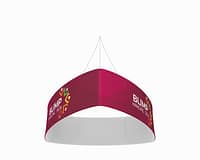In an age where visual communication is paramount, the ubiquitous presence of banners—especially the eye-catching 1m banners—has become a staple in advertising, events, and public messaging. While these banners effectively convey messages and attract eyeballs, their environmental implications often go unnoticed. This article delves into the hidden costs associated with the production and disposal of 1m banners, followed by a discussion on innovative solutions that can help mitigate their ecological footprint.
Unveiling the Hidden Costs: 1m Banners and Our Planet
The production of 1m banners typically involves the use of PVC (polyvinyl chloride), a plastic that poses significant environmental challenges. The manufacturing process not only consumes vast amounts of energy but also releases harmful chemicals into the atmosphere, contributing to air pollution. Furthermore, the extraction of raw materials—petroleum—leads to habitat destruction and biodiversity loss. The sheer volume of these banners produced annually translates to a staggering environmental toll, as each one carries with it an invisible burden of ecological disruption.
Once the promotional event ends or the message becomes outdated, the life cycle of a 1m banner doesn’t end gracefully. Most banners find their way to landfills, where they can take hundreds of years to decompose. The degradation process can release toxic substances into the soil and groundwater, causing long-lasting damage to ecosystems. Additionally, the burning of discarded banners releases greenhouse gases and other pollutants, further exacerbating climate change. Thus, the environmental impact of 1m banners extends far beyond their immediate use.
Moreover, the prevalence of 1m banners in various sectors amplifies their cumulative effect on the environment. From trade shows to political campaigns, the constant demand for these promotional tools signifies a throwaway culture. This culture not only promotes unsustainable practices but also undermines efforts to create a circular economy. As banners become obsolete in a matter of days or weeks, the cycle of production, consumption, and disposal perpetuates a cycle that is detrimental to our planet.
Innovative Solutions: Reducing the Footprint of Banners
Amid growing concerns over environmental sustainability, innovative solutions are emerging to reduce the ecological footprint of banners. One promising approach is the use of biodegradable materials, such as organic cotton or hemp, which can replace traditional PVC without sacrificing visual appeal. These materials break down naturally, minimizing the risk of pollution and landfill overflow. Moreover, advancements in printing technology allow for the use of water-based inks, which are less toxic and more environmentally friendly than their solvent-based counterparts.
Another effective solution is the implementation of a rental system for banners. Event organizers can rent reusable banners that can be adapted for different occasions, significantly reducing the need for new production. Companies specializing in banner rentals are already paving the way for more sustainable practices, ensuring that designs can be reused and repurposed across multiple events. This model not only lessens waste but also promotes a mindset shift towards valuing longevity and resourcefulness in promotional materials.
Lastly, incorporating digital alternatives can revolutionize the way we communicate messages without relying on physical banners. Digital screens, social media promotions, and mobile advertising offer dynamic ways to reach audiences without the environmental baggage that comes with traditional banners. By embracing these technologies and encouraging businesses to adopt them, we can significantly curtail the demand for new banners and foster a culture that prioritizes sustainability.
The environmental impact of 1m banners is a pressing concern that calls for immediate attention and action. While their utility in communication is undeniable, the hidden costs associated with their production and disposal cannot be overlooked. However, as we explore innovative solutions—ranging from biodegradable materials to digital alternatives—we can pave the way towards a greener future. By rethinking our approach to banners and promoting sustainable practices, we can ensure that our messages do not come at the expense of our planet. Together, we can create a balance between effective communication and environmental stewardship, safeguarding our world for future generations.



